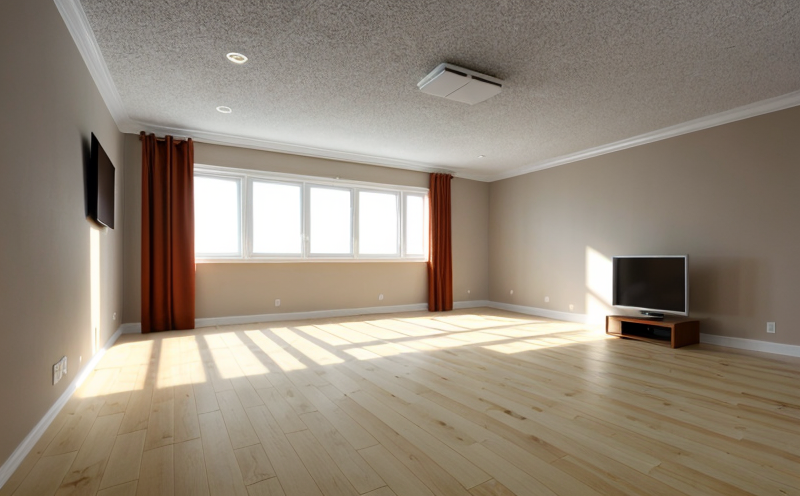ISO 140-4 Airborne Sound Insulation Testing of Rooms
The ISO 140-4 standard provides a comprehensive framework for testing airborne sound insulation in rooms, which is essential for ensuring compliance with noise regulations and improving the acoustic comfort of buildings. This service focuses on the detailed procedure outlined in ISO 140-4 to assess the ability of partitions, floors, and roofs to prevent unwanted sound from passing between spaces.
The process involves measuring airborne sound transmission through a partition or floor/ceiling assembly using a specified test setup. The goal is to quantify the reduction in sound pressure level (SPL) across the partition due to the presence of the structure under test (SUT). This measurement helps determine if the SUT meets the required performance criteria for noise insulation.
The testing procedure typically begins with selecting appropriate test frequencies, which are usually 125 Hz, 250 Hz, 500 Hz, 1 kHz, 2 kHz, and 4 kHz. These frequencies cover a wide range of audible sounds from low-frequency rumble to high-pitched noises.
The SUT is installed in a test room with carefully controlled conditions, including temperature, humidity, and background noise levels. The test setup consists of two rooms separated by the partition or floor/ceiling assembly being tested. One room acts as the source room where sound is generated using calibrated noise generators, while the other serves as the receiver room.
Before testing begins, it's crucial to ensure that all openings in the SUT are sealed and that any air gaps around doors or windows are filled with appropriate materials. This step ensures accurate measurements by preventing sound from bypassing the partition.
The test procedure involves measuring the average sound pressure levels (SPL) at various points along both sides of the partition using microphones connected to a sound level meter. The difference between the source room and receiver room SPLs provides an indication of the airborne sound insulation performance of the SUT.
Once the measurements are taken, they are compared against the specified performance criteria outlined in ISO 140-4. If the SUT fails to meet these criteria, further investigation may be necessary to identify potential issues and implement corrective measures.
This testing method is widely used in various sectors such as residential construction, commercial buildings, healthcare facilities, and educational institutions where sound insulation is critical for maintaining privacy and reducing noise pollution. By adhering to the strict standards set forth by ISO 140-4, architects, engineers, and building owners can ensure that their projects comply with relevant regulations and provide occupants with a more comfortable living or working environment.
The results of these tests are typically reported in a detailed certificate that includes all measured data points along with the calculated sound reduction indices (SRI). These certificates serve as valuable documentation for both regulatory compliance purposes and quality assurance within the construction industry.
Scope and Methodology
The scope of ISO 140-4 Airborne Sound Insulation Testing is focused on evaluating the ability of partitions, floors, and ceilings to block unwanted sound from passing between different rooms or spaces within a building. This type of testing ensures that structures meet the necessary performance criteria for noise insulation as defined by relevant standards.
The methodology involves setting up a controlled environment in which two rooms are separated by the partition or floor/ceiling assembly being tested. In one room, sound is generated using calibrated noise generators; this room serves as the source room. Meanwhile, the other room acts as the receiver room where measurements of airborne sound levels are taken.
Before starting the test, it's important to ensure that all potential sources of error are minimized by sealing any openings in the SUT and filling air gaps around doors or windows with appropriate materials. This step helps guarantee accurate results by preventing sound from finding alternative pathways through the structure under examination.
The actual testing process consists of measuring the average sound pressure levels (SPL) at specific locations along both sides of the partition using microphones connected to a sound level meter. By comparing the SPLs in the source and receiver rooms, one can determine how much sound is being transmitted through the SUT.
The measured values are then compared against predetermined performance criteria set forth by ISO 140-4. If these criteria aren't met, it may indicate that additional work is needed to improve the sound insulation properties of the structure under test.
Industry Applications
| Industry Sector | Description |
|---|---|
| Residential Construction | This testing ensures that walls and floors in residential buildings meet the required noise insulation standards, providing a quieter living environment for residents. |
| Commercial Buildings | In office spaces or retail environments, maintaining sound privacy between different areas is crucial. ISO 140-4 testing helps achieve this by ensuring adequate sound insulation. |
| Healthcare Facilities | Patient rooms and common areas in hospitals need to be acoustically isolated to protect patients from excessive noise levels that could affect their recovery. |
| Educational Institutions | Schools and universities benefit from this testing as it ensures classrooms are free from disruptive background noises, enhancing learning outcomes for students. |
Environmental and Sustainability Contributions
The implementation of ISO 140-4 Airborne Sound Insulation Testing contributes significantly to environmental protection by reducing noise pollution in various settings. By ensuring that buildings comply with strict sound insulation standards, this practice helps minimize the negative impacts of excessive noise on both human health and wildlife.
For instance, in residential areas, well-insulated homes contribute to lower outdoor noise levels, which can reduce stress for residents and improve sleep quality. In urban environments, reducing noise pollution also benefits local ecosystems by minimizing disturbance caused by loud noises.
In addition to these direct environmental benefits, implementing sound insulation measures aligns with broader sustainability goals such as energy efficiency and resource conservation. Quieter buildings often require less mechanical ventilation due to reduced air movement through gaps in partitions, leading to potential savings on heating, cooling, and electricity costs over time.





